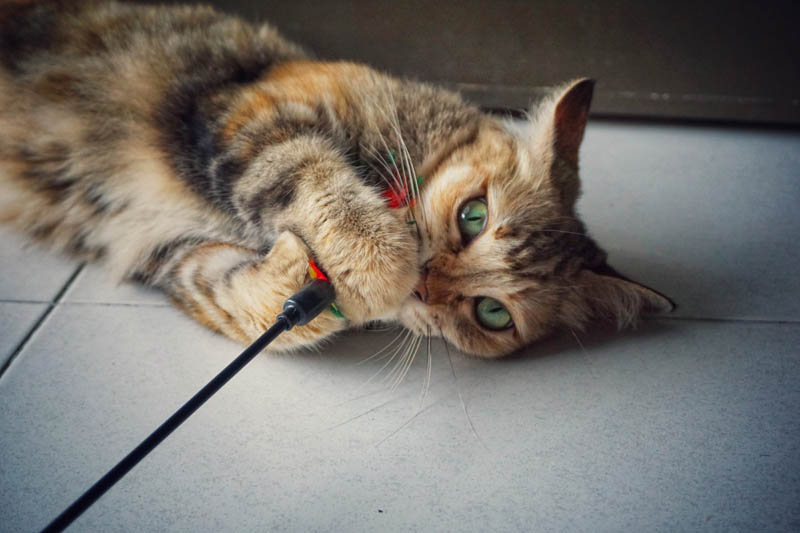Are cats nocturnal?
Cats are crepuscular (active at twilight and dawn) and not nocturnal (active at night). This offers our cat’s desert-dwelling wild ancestors an evolutionary advantage. By sleeping during the day when temperatures are at their highest, the feline conserves energy. A crepuscular cycle also matches that of their preferred prey, small rodents and some species of birds who are also active at dusk and dawn.
How can cats see in low light?
Cats have evolved a number of mechanisms that help them to locate their prey in low light.
Tapetum lucidum: The tapetum lucidum is a reflective layer located behind the light-sensitive retina. Its role is to reflect light back onto the retina, allowing it to receive light a second time, and enhancing visibility in low light. This reflection is what we see when we see a cat’s eyes glow when light is shone into them.
Pupil size: In poor light, the cat’s pupils are able to dilate (enlarge), which allows more light to hit the retina. Researchers at UC Davis, California, found cats experience a 135-fold change in pupil size compared to humans who only experience a 15-fold change.
More rods than cones: The retina contains two cell types of photoreceptor cells, rods and cones. Rods assist with peripheral and night vision and cones are responsible for colour and fine vision. Cats have 25 rods to each cone, compared to people who have four rods to each cone. The greater number of rods to cones makes the cat better equipped to see in low light. In fact, cats can see in one-eighth of the illumination that humans need.
If cats aren’t nocturnal, why are they so active at night?
As crepuscular predators, cats are most active at dusk and dawn. They often experience peak periods of awakeness in the early morning which is when they would be out hunting in nature. This may be exacerbated in spring and summer when the sun rises earlier. As frustrating as it is, the cat is not being naughty, they are just following their hardwired behaviour.
Boredom:
As more and more cats are kept indoors and often spend extended periods of time alone, they can experience boredom if they are not provided with both mental and physical stimulation. Cats need to be given the opportunity for both physical exercise and mental stimulation. Daily play sessions, interactive games and food toys are important features that should be incorporated into the daily life of cats. Don’t leave every toy out all the time, instead, rotate toys to keep the cat mentally stimulated. Scrunched-up paper balls, ping pong balls, corks, toy mice, cardboard boxes and interactive puzzles all make great toys.
Senility:
Just like humans, a cat’s cognitive ability can decline as he or she ages. Altered sleep cycles, confusion, pain, and anxiety can all impact a cat’s sleep routine. DISHAAL is an acronym that summarises common symptoms of dementia.
- Disorientation
- Interactions (changes in interactions with owners, other pets and the environment)
- Sleep-wake cycle disturbances
- Housesoiling
- Activity (changes in/repetitive)
- Anxiety
- Learning
Hunger:
Loneliness:
Kittens in particular can find a new home without their mother or siblings overwhelming and may cry at night when left alone. They have been used to the warmth and comfort of their mother until now. Provide the kitten with a cuddly toy and a hot water bottle (wrapped in a blanket to prevent burns) to snuggle up to so they don’t feel as lonely.
What you can do
The good news is that most cats will adapt to the lifestyle of their human family. One small study of ten cats from the Faculty of Veterinary Medicine, University of Messina found that cats take on the routine and habits of their owners. During the study, five cats were provided free access to a 20-40 m2 garden between 8:00 a.m. to 9:00 p.m. The second group had access to had free access to a 2000-2500 m2 garden all day, and from 21:00 p.m. to 08:00 a.m. they were kept outside. Group A maintained a strong symbiosis with their owners and was most active during the day, while group B exhibited the greatest level of activity at night.
Create a routine:
In the wild, a cat will stalk their prey, kill, eat, groom and sleep. As pet owners, we can provide a similar experience. Before bedtime, play an active hunting-type game (wand toys are the best for this) to burn off some energy. Don’t wildly wave the toy around, but move it in a way a mouse or bird would behave. Allow the cat to get close, before moving it away, and end the game by letting the cat catch the target, and follow up with a meal.

Ignore attention-seeking:
If your cat does wake you in the early morning, do not get up and provide a meal or play with the cat as this reinforces the behaviour.

Make the bedroom out of bounds for play:
The bedroom should be a place for sleeping and not play. Start out as you plan to continue, and create specific areas for play that are well away from the bedroom.
Sleep alone:
This one may sound controversial, but it may be necessary to keep your cat out of the bedroom when you are sleeping. As much as I would love to have my cats in the bedroom, they just can’t make it through the night without waking me, not for play, but they need their litter tray, a drink or some food. Therefore, I have my bedroom, and they have the remainder of the house at night with access to everything they need.

